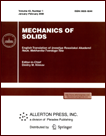 | | Mechanics of Solids
A Journal of Russian Academy of Sciences | | Founded
in January 1966
Issued 6 times a year
Print ISSN 0025-6544
Online ISSN 1934-7936 |
Archive of Issues
| Total articles in the database: | | 13362 |
| In Russian (Èçâ. ÐÀÍ. ÌÒÒ): | | 8178
|
| In English (Mech. Solids): | | 5184 |
|
| << Previous article | Volume 60, Issue 3 / 2025 | Next article >> |
| Feng Sun, Hengran Cao, Zheng Liu, Xudong Zhang, and Shifeng Xue, "Discrete Numerical Modeling of Macro-mesoscopic Mechanical Behaviors of Longmaxi Shale under High Temperature," Mech. Solids. 60 (3), 1822-1839 (2025) |
| Year |
2025 |
Volume |
60 |
Number |
3 |
Pages |
1822-1839 |
| DOI |
10.1134/S0025654425600795 |
| Title |
Discrete Numerical Modeling of Macro-mesoscopic Mechanical Behaviors of Longmaxi Shale under High Temperature |
| Author(s) |
Feng Sun (College of Pipeline and Civil Engineering, China University of Petroleum (East China), Qingdao, 266580 China, upcsfeng@upc.edu.cn)
Hengran Cao (College of Pipeline and Civil Engineering, China University of Petroleum (East China), Qingdao, 266580 China)
Zheng Liu (College of Pipeline and Civil Engineering, China University of Petroleum (East China), Qingdao, 266580 China)
Xudong Zhang (College of Pipeline and Civil Engineering, China University of Petroleum (East China), Qingdao, 266580 China)
Shifeng Xue (College of Pipeline and Civil Engineering, China University of Petroleum (East China), Qingdao, 266580 China) |
| Abstract |
The mechanical properties of deep shale are influenced by various factors, including high-temperature and high-pressure conditions, as well as its bedding structure. To investigate the evolution of mechanical properties of deep shale under different environmental temperatures, this study takes the Longmaxi Formation shale as an example, conducting high-temperature and high-pressure triaxial tests. Additionally, a thermal-mechanical coupled particle flow model for deep shale with a bedding structure is established from both macroscopic and mesoscopic perspectives. Based on X-ray diffraction experiments to determine the mineral composition and content of the shale, the model assigns the number of grouped mineral particles and their thermal expansion coefficients. Meanwhile, smooth joint contact is incorporated to characterize the influence of bedding structure, and the model’s mesoscopic parameters are calibrated using high-temperature and high-pressure triaxial test results. Based on the triaxial experiments and the thermal-mechanical coupled model, this study investigates the variations in mesoscopic thermal damage, rock mechanical properties, and failure modes of layered shale under different environmental temperatures. The results indicate that high temperature conditions weaken the mechanical properties of shale, while high confining pressure reduces the anisotropy of layered shale. As temperature increases, thermal damage initially occurs at the bedding interfaces. When the temperature exceeds 150°C, mineral particles undergo shear displacement, leading to a sparse distribution of mesoscopic force chains, and macroscopic thermal cracks expand extensively. In high-temperature and high-pressure environments, the thermal-mechanical coupling effect causes a reduction in the peak strength and an increase in peak strain, with the failure mode transitioning from brittle failure to plastic-ductile failure. Meanwhile, bedding cracks branch and gradually extend into the matrix, forming a composite failure mode involving both the shale matrix and the bedding structure. |
| Keywords |
Deep shale, Bedding, Particle flow method, Thermo-mechanical coupling, Mechanical property |
| Received |
19 February 2025 | Revised |
19 March 2025 | Accepted |
31 March 2025 |
| Link to Fulltext |
|
| << Previous article | Volume 60, Issue 3 / 2025 | Next article >> |
|
 If you find a misprint on a webpage, please help us correct it promptly - just highlight and press Ctrl+Enter If you find a misprint on a webpage, please help us correct it promptly - just highlight and press Ctrl+Enter
|
|

 Russian
Russian  English
English